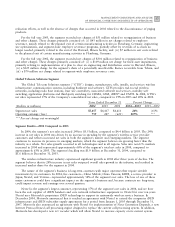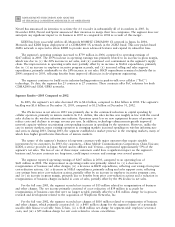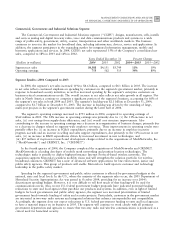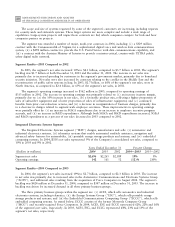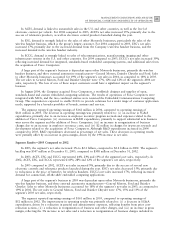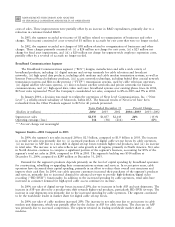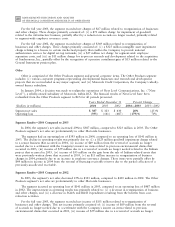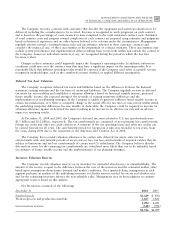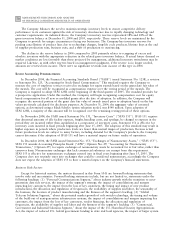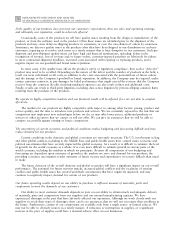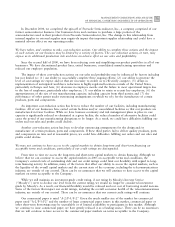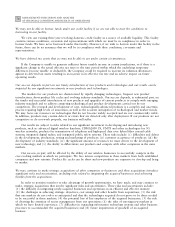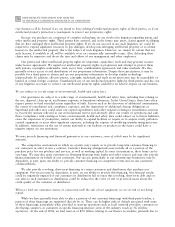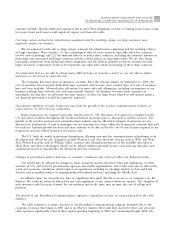Motorola 2004 Annual Report Download - page 75
Download and view the complete annual report
Please find page 75 of the 2004 Motorola annual report below. You can navigate through the pages in the report by either clicking on the pages listed below, or by using the keyword search tool below to find specific information within the annual report.
67
MANAGEMENT'S DISCUSSION AND ANALYSIS
OF FINANCIAL CONDITION AND RESULTS OF OPERATIONS
Exit costs primarily consist of future minimum lease payments on vacated facilities. At each reporting date, the
Company evaluates its accruals for exit costs and employee separation costs to ensure the accruals are still
appropriate. In certain circumstances, accruals are no longer required because of eÇciencies in carrying out the
plans or because employees previously identiÑed for separation resigned from the Company and did not receive
severance or were redeployed due to circumstances not foreseen when the original plans were initiated. The
Company reverses accruals through the Reorganization of Businesses income statement line item when it is
determined they are no longer required.
Allowance for Losses on Finance Receivables
The Company has historically provided Ñnancing to certain customers in connection with purchases of the
Company's infrastructure equipment. Financing provided has included all or a portion of the equipment purchase
price, as well as working capital for certain purchasers.
Gross Ñnancing receivables were $2.1 billion at December 31, 2004 and $2.4 billion at December 31, 2003,
with an allowance for losses on these receivables of $2.0 billion and $2.1 billion, respectively. Of the receivables at
December 31, 2004, $2.0 billion ($7 million, net of allowance for losses of $2.0 billion) were considered impaired
based on management's determination that the Company will be unable to collect all amounts in accordance with
the contractual terms of the relevant agreement. By comparison, impaired receivables at December 31, 2003 were
$2.2 billion ($133 million, net of allowance for losses of $2.1 billion).
At December 31, 2004 and 2003, the Company had $1.9 billion and $2.0 billion of gross receivables from one
customer, Telsim. The decline represents partial recovery of amounts owed of $44 million due to collection eÅorts
during 2004. As a result of diÇculties in collecting the amounts due from Telsim, the Company has previously
recorded charges reducing the net receivable from Telsim to zero.
Management periodically reviews customer account activity in order to assess the adequacy of the allowances
provided for potential losses. Factors considered include economic conditions, collateral values and each customer's
payment history and credit worthiness. Adjustments, if any, are made to reserve balances following the completion
of these reviews to reÖect management's best estimate of potential losses. The resulting net Ñnance receivable
balance is intended to represent the estimated realizable value as determined based on: (i) the fair value of the
underlying collateral, if the receivable is collateralized, or (ii) the present value of expected future cash Öows
discounted at the eÅective interest rate implicit in the underlying receivable.
Retirement-Related BeneÑts
The Company accounts for its pension beneÑts and its postretirement health care beneÑts using actuarial
models required by SFAS No. 87, ""Employers' Accounting for Pensions,'' and SFAS No. 106, ""Employers'
Accounting for Postretirement BeneÑts Other Than Pensions,'' respectively. These models use an attribution
approach that generally spreads individual events over the service lives of the employees in the plan. Examples of
""events'' are plan amendments and changes in actuarial assumptions such as discount rate, expected long-term rate
of return on plan assets, and rate of compensation increases. The principle underlying the required attribution
approach is that employees render service over their service lives on a relatively consistent basis and, therefore, the
income statement eÅects of pension beneÑts or postretirement health care beneÑts are earned in, and should be
expensed in, the same pattern.
There are various assumptions used in calculating the net periodic beneÑt expense and related beneÑt
obligations. One of these assumptions is the expected long-term rate of return on plan assets. The required use of
expected long-term rate of return on plan assets may result in recognized pension income that is greater or less than
the actual returns of those plan assets in any given year. Over time, however, the expected long-term returns are
designed to approximate the actual long-term returns and therefore result in a pattern of income and expense
recognition that more closely matches the pattern of the services provided by the employees. DiÅerences between
actual and expected returns are recognized in the net periodic pension calculation over Ñve years.
The Company uses long-term historical actual return experience with consideration of the expected investment
mix of the plans' assets, as well as future estimates of long-term investment returns to develop its expected rate of
return assumption used in calculating the net periodic pension cost and the net retirement healthcare expense. The
Company's investment return assumption for the Regular Pension Plan and Postretirement Health Care BeneÑts


